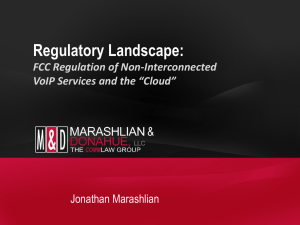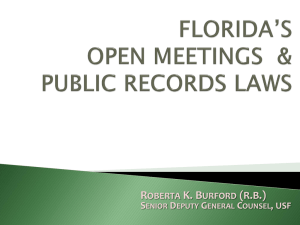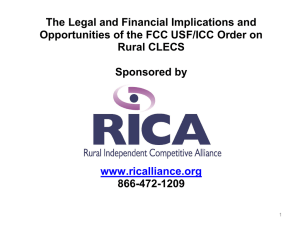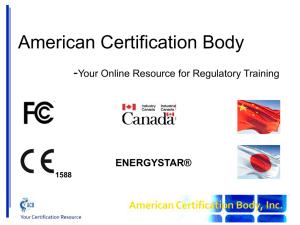Texas SB 5 & Intrastate Access Charges – What changes
advertisement
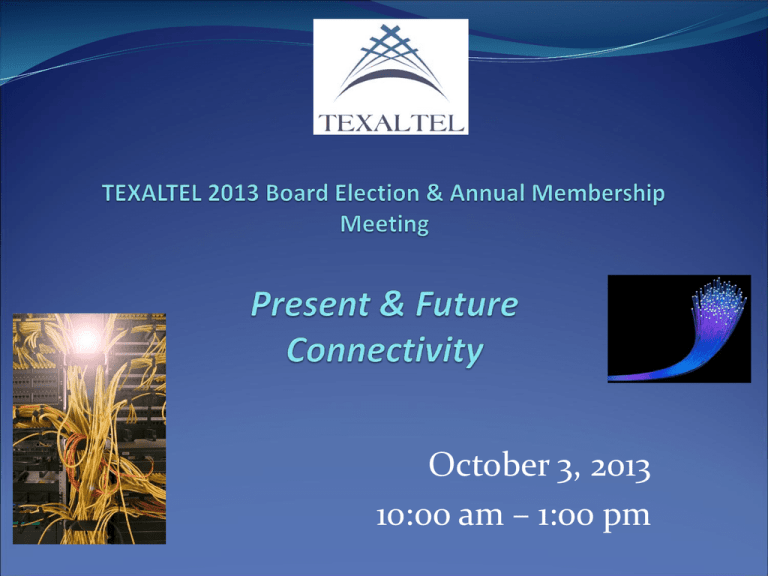
October 3, 2013 10:00 am – 1:00 pm Agenda 10:00 am – TEXALTEL Annual Membership Meeting – Board Elections Board Elections: All officers and two directors –at -large. 10:15 am – 1:00 pm TEXALTEL’s 2013 Business & Regulatory Webinar FCC – Proceedings at the FCC that impacts present and future connectivity Presenter: Jerry James, CEO, CompTel Where is IP Interconnection & Copper Retirement? Presenter: Tiki Gaugler, Senior Attorney, XO Wholesale Last Mile Fiber Access Presenter: Jason Wakefield, Member, Herrera & Boyle Universal Service Funding: FCC Push to Service Specific Model and Texas Takes up Needs Test Requirement Presenter: Charles Land, TEXALTEL October 3, 2013 Present Officers & Board Members Howard Siegel, Logix – President* Jared Benson – Vice President* Katherine Mudge, MegaPath– Secretary* Patti Hogue, Alpheus – Treasurer* Dale Schneberger, Grande – Director* Matt Edmuston, Meriplex – Director Nancy Lubamersky, TelePacific – Director Robert McCausland, Hypercube – Director Steve Savens, Bestline – Director* *Seat up for election Nomination and Voting Rules Nominations have been made: All seated board members have been nominated for re-election. Additional nominations may be made at the time of the election. Each member company is asked to decide which person is to cast votes for that company. One representative for each company will be asked to provide a voice vote for the candidates. The Leading Industry Association Representing Competitive Communications Service Providers and their Supplier Partners Hill focus FCC Oversight hearings Spectrum auction Processes/procedures/merger conditions Senate wireline hearing Confirmation of FCC nominees Legislation – Cybersecurity/Privacy FCC Leadership Transition Tom Wheeler as new FCC Chairman New Staff Priorities Michael O’Rielly as new Commissioner (R) Interim Chairwoman Clyburn Timing Top Issues IP Interconnection - VIOP trials/ Numbering issues Last Mile – Copper retirement/packetized loop and Special Access Reform Network deployment issues Money - USF /CAF/E-rate/spectrum Special Access Data Request Clarification/Modification to Mandatory special access data request released on 9/17/13 OMB approval required; Date for filing data TBD Clarifies Scope of Data Collection, e.g.,: List specific exclusions from definition of “purchaser” Clarifies that only applies to price cap areas during relevant time period All relevant Form 477 filers must file even if just to certify that they are not a “purchaser,” “provider” or “Best Efforts Business Broadband Internet Access Service Provider” Provides submitting instructions and record format specifications Modifies and amends questions and definitions contained in the collection USF Reform Phase 2 Who pays? Who is eligible for the money? What qualifies for approved uses of the money? What is the potential impact on competitive carriers? VOIP Numbering Trial What has been proposed? OTT providers to have direct access to numbers. Our Concerns Certificated carriers have pro-consumer and pro – competition obligations OTT providers do not have the same requirements Network design issues for call handling Impact on other issues – IP ICAs Regulatory jurisdiction for OTT VOIP Cybersecurity All agree there is a problem. All agree to work to protect their network and their customers. It is not a “one-size” fits all solution. Liability? Costs? Privacy issues? What should you be doing? Rural Call Completion Order requires carrier to retain call records to calculate per cent call completion. Burden on the provider. Prohibits carrier from providing ringback until the call is terminated. Safe harbor if use 2 or less intermediate carriers Complaints may lead to FCC action. Key issues which need to be considered: Why are calls not completing? ILEC, 3rd party, other? Spectrum Auction When? 2014 What? AWS-3 Band Who? Managed bid process Where? Cellular Market Areas (CMA) versus Economic Areas (EA) Impact Competition/Consumers/Coverage Network Deployment Issues Pole attachments- access and rates Right a ways Building access State Legislation Watch About 25 states have passed legislation Deregulate retail offerings No Carrier of Last Resort obligation No jurisdiction under state law for VOIP California status Michigan Stakeholder alliances COMPTEL TEXALTEL – OCTOBER 2013 Tiki Gaugler Senior Attorney, Regulatory tikigaugler@xo.com About xo communications One of the nation’s largest providers of innovative broadband and other competitive services XO has deployed IP technology into its nationwide network and began offering VoIP services to retail customers over a decade ago XO’s VoIP nationwide footprint covers 2,700 cities across the U.S. and in nearly every state XO offers converged IP voice and data communications services over a single access facility, including local and long distance calling, dedicated Internet access, and web hosting, as well as virtual private networking Technology overview Time Division Multiplexing (TDM) Signals transmitted over dedicated connection established for duration of call Utilizes circuit-switched network with fixed number of channels and constant bandwidth per channel Internet Protocol (TCP/IP) Data grouped into packets, regardless of content, type, or structure, that are individually transmitted on shared connection then reassembled at destination Utilizes packet-switched network that allocates transmission resources as needed for dynamic capacity Packet of information flows through multiple layers, from the application layer down to the physical layer where it is placed on the cable and sent to its destination and then flows back up to the application layer Voip services Over-the-top VoIP services utilize the public Internet for at least a portion of transporting a call The public Internet uses best efforts routing that treats all packets the same and relies on buffering to control congestion, which may degrade call quality Managed VoIP services utilize private IP networks with packet prioritization and traffic segmentation A managed-packet network is able to combine the quality standards of the PSTN with the flexibility of a packet-based network to assure quality of service Technology transition Public Internet traffic and managed VoIP traffic may use the same network protocol but typically traverse over separate physical interconnection facilities IP transition involves the evolution of network technology, not of physical network facilities Due to quality of service and flexibility benefits, the transition of the Public Switched Telephone Network (PSTN) is likely to follow the course of managed VoIP services with interconnected private networks, rather than that of the public Internet A separate Public Communications Network (PCN) will still exist even as the network technology transitions from circuitswitched to packet-switched Copper retirement IP-based services may be provided over the same types of physical layer as TDM-based services (i.e., copper, fiber, coaxial cable, wireless spectrum) Existing copper facilities allow more rapid and costeffective deployment of broadband than fiber Copper plant is ubiquitous nationwide Advances in technology have enabled deployment of Ethernet-over-copper with speeds up to 100-200 Mbps Copper retirement rules should be updated to require public interest showing and FCC approval prior to retirement, prohibit physical removal of copper even after retirement, and require ILECs to provide CLECs with access to retired copper facilities and comprehensive data regarding copper availability Interconnection scenarios TDM-VoIP Interconnection Media and signaling gateways provide protocol conversion at network edge Primary issue is which party is responsible for costs of conversion IP-in-the-middle Utilizes IP transport deployed in carrier networks Traffic exchange can occur in IP even though end users are served with TDM VoIP-to-VoIP Ultimate goal is to provide end-to-end IP to allow enhanced features and functionality Policy considerations ILECs maintain market power and terminating monopoly regardless of technology transition; forbearance must be required for regulatory relief Telecommunications Act is technology neutral and sections 251 and 252 apply to managed IP interconnection Regulation of managed IP interconnection would not equate to regulation of public Internet content or peering arrangements Once the appropriate regime for IP interconnection is established, market forces can dictate the pace of IP deployment in individual carrier networks state commission activity Texas – SB-980 prohibits PUC from regulating VoIP or IP- enabled services Illinois – Sprint/AT&T ICA arbitration Massachusetts – DTC opened investigation and required Verizon to file ICA that includes IP interconnection California – SB-1161 prohibits PUC from regulating VoIP or IP-enabled services FCC activity ICC Transformation Order & NPRM Attempted to eliminate barriers to IP interconnection by clarifying that providers must negotiate in good faith upon request for IP interconnection arrangements Technology Transitions Policy Task Force Formed to provide recommendations to the FCC to modernize FCC policies and will hold periodic workshops Public Notice sought comment on potential industry trials regarding IP interconnection, wire center all-IP networks, NG911, copper to fiber transition, wireline to wireless transition, and others VoIP Numbering Order, NPRM, & NOI Established trial for interconnected VoIP providers to gain direct access to numbering resources Sought comment on various database and routing issues Jason Wakefield Herrera & Boyle, PLLC October 3, 2013 Wholesale Options CLECs ILECs & cable companies Other options 30 CLECs (in alphabetical order) Alpheus tw telecom XO Zayo Others? 31 Alpheus Fiber presence in Dallas/Fort Worth, Houston, Austin, San Antonio, San Marcos, Corpus Christi, Harlingen, Laredo, and McAllen http://www.alpheus.net/4-2/alpheus-network/ Wholesale services Dark fiber and Ethernet, 51 Mbps to 1 Gigabit http://www.alpheus.net/terms/terms-and-conditions/ 32 tw telecom Fiber presence in Dallas/Fort Worth, Houston, Austin, San Antonio, El Paso and Corpus Christi http://www.twtelecom.com/sales-services/ Wholesale services DS0 to OC-48 Tariffed prices starting from $135/month plus $100/mile for DS1s and $1150/month plus $300/mile for DS3s Special construction charges (ICB) for new construction http://www.twtelecom.com/telecomsolutions/wholesale-ethernet/ 33 XO Fiber presence in Dallas/Fort Worth, Houston, Austin, and San Antonio http://www.xo.com/carrier/internet- access/dedicated/ Wholesale services DS1 to 100 Gigabit Ethernet Pricing not listed on website Special construction charges (ICB) for new construction http://www.xo.com/legal-and-privacy/product-termsand-conditions/ 34 Zayo Fiber presence in Dallas/Fort Worth, Houston, Austin, San Antonio, El Paso, Amarillo, Lubbock, Corpus Christi, Laredo, Midland, Killeen, Waco, and Denton http://www.zayo.com/interactive-network-map Build-operate-transfer model CLEC pays MRC for dark fiber built by Zayo, then can take ownership after set number of years $1,000 to $3,500 MRC, depending on location See attached presentation Example: partnership with Cbeyond 35 Observations CLEC offerings typically limited to larger metro areas Joint venture of multiple CLECs to cover more of the state? 36 ILECs and Cable Companies AT&T https://primeaccess.att.com/shell.cfm?section=89 Verizon http://www22.verizon.com/wholesale/solutions/solution/tran sparent%2Blan%2Bservice.html CenturyLink http://www.centurylink.com/business/products/productsand-services/data-networking/metro-optical-ethernet.html Time Warner http://www.timewarnercable.com/en/businesshome/solutions/carrier-reseller/wholesale-ethernetaccess.html Comcast http://www.comcast.com/dedicatedinternet/?SCRedirect=true Willingness to partner in this type of business model? 37 Other Options Partnership with engineering firm Capex up front, unless firm accepts build-operatetransfer model $500+ per location passed, plus $500+ per installation http://fastnetnews.com/fiber-news/175-d/4835-fibereconomics-quick-and-dirty Partnership with local governments Google Fiber example Reasonable access to poles, conduits, and permits 38 Fiber Presence - Texas Amarillo El Paso Build-Operate-Transfer Model CLEC pays MRC for dark fiber Lubbock Denton Midland Dallas Fort Worth Waco Killeen Houston Austin San Antonio Corpus Christi Laredo built by Zayo, then can take ownership after set number of years $1,000 to $3,500 MRC, depending on location See attached presentation Similar existing partnership with a National Carrier/ISP company http://www.zayo.com/interactive-network-map 39 Questions? Jason Wakefield Herrera & Boyle, PLLC 816 Congress, Suite 1250 Austin, Texas 78701 (512) 474-1492 (o) (512) 364-2261 (m) jwakefield@herreraboylelaw.com 40 Changing the Landscape By: Charles D. Land, P.E. Executive Director, TEXALTEL Affects Wholesale Service USF Exemption Timeline FCC Order adopted November 1, 2012 in WC Docket No. 06-122 Effective for 499A reports after 1-1-2014. Comments filed September, 2013 on Form 499-A instructions Status Quo Each reseller certifies annually to wholesale provider that it pays USF on retail services and is exempt on wholesale. USAC has rankled many with audits and many reclassifications from reseller to end user – big back bills to wholesalers. Objectives of Proceeding Broaden the base on which interstate USF is paid. Address requests for clarification from USAC Address issues raised by carriers Changes Resellers must certify by service that they are reselling. Reselling defined to be: 1) incorporates the purchased telecommunications services into its own offerings and 2) can reasonably be expected to contribute to support universal service based on revenues from those offerings. What changed? Services purchased to provide internet service (which is not subject to USF) and other services not subject to USF assessment are no longer USF exempt. When doing an audit, USAC is required to consider “other reliable proof” that the wholesaler’s customer is a reseller. In the past USAC assessed USF if wholesaler failed to follow 499 instructions, even if there was evidence that the customer is a reseller. Double collection prohibited – if the wholesaler can show by clear and convincing evidence that the reseller paid USF on services provided with the resold service, USAC cannot require the wholesaler to pay USF fees on that service A wholesaler who complies with all instructions with Form 499-A has a “safe harbor” and USAC cannot reclassify revenues as “end user” and assess additional fees. What was clarified? XOCS had outdated reseller certificates (some taken when service first provided, some obtained during the audit 3 years later). FCC said these are not acceptable to show “reasonable expectation” but may be considered as “other reliable proof” that USF fees were paid. TelePacific asked that all services obtained for resale be exempt, including those to provide internet or other retail services not subject to USF. FCC denied relief. Result is that network based providers pay no fees on internet services and resellers pay USF fees on transport purchased to provide internet. “Safe Harbor” –if the provider demonstrates that it has a reasonable expectation that its customer is contributing as a reseller “based on the guidance provided in the FCC Form 499-A instructions”. This means customer annual certifications are in hand when the carrier files its 499-A report. If the reseller lies, wholesale provider is not liable. A provider who fails to show “reasonable expectation” (didn’t follow the form 499-A instructions) may submit “other reliable proof” when USAC audits. Providers are expected to see that customers are in the FCC data based as USF payers. Proof that each service provided is used to provide a service on which the reseller pays USF is also required. If USAC finds during the audit that the customer lied, or for any other reason isn’t a “reseller”, wholesaler is likely liable. What does this mean to TEXALTEL members? Make careful note of “mixed use”. If a wholesale service is used to provide 2 or more services, some of which are subject to USF and some not, the reseller may still certify that the service is resold and eligible for USF exemption if the reseller pays on those services subject to USF assessment. Be sure that certification forms are turned in timely each year on each wholesale service (depending on form 499-A instructions, maybe by class of service). Expect that any wholesale service used exclusively to provide internet will be subject to USF. Wholesale providers – watch closely when the Form 499-A instructions are issued. All – this will require changes in how you do parts of your business. Don’t snooze or you will lose. Remember the FCC’s goal – any transport associated with internet service is “telecommunications” and subject to USF. They haven’t fully accomplished this yet, but this is what they think they are doing.
